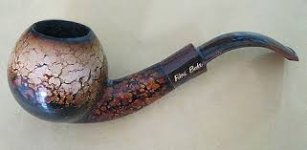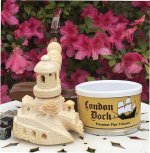Mine are like hard Styrofoam, little to no heft at all.I see a lot of meerschaum pipes of the same dimensions as briar, just as heavy.
Do Differences in Meershaum Pipes Quality Exist ad/or Matter?
- Thread starter TN Jed
- Start date
You are using an out of date browser. It may not display this or other websites correctly.
You should upgrade or use an alternative browser.
You should upgrade or use an alternative browser.
SmokingPipes.com Updates
Watch for Updates Twice a Week
- Status
- Not open for further replies.
I should of said, not every single one out there appears heavy, but there are still a lot of them, the weight differences aren’t like what this person mentioned before as Light as a Feather either.
This seems like possibly a good example a $300 pipe, so in this market place today, should $300 be considered good quality and low weight? The weight of the pipe is 59 grams...
This one is a wopping 82 grams ouch...
I’ve also noticed some pretty good weight on Altinay’s and Altinok’s pipes.
This Altinok is a small pipe, yet this weighs 41grams, this is almost as heavy as my Radice Rind Straight, and the Radice is a much bigger pipe.
I expected that Altinok to be more like 30 grams.
This seems like possibly a good example a $300 pipe, so in this market place today, should $300 be considered good quality and low weight? The weight of the pipe is 59 grams...
This one is a wopping 82 grams ouch...
I’ve also noticed some pretty good weight on Altinay’s and Altinok’s pipes.
This Altinok is a small pipe, yet this weighs 41grams, this is almost as heavy as my Radice Rind Straight, and the Radice is a much bigger pipe.
I expected that Altinok to be more like 30 grams.
Last edited:
That's really not a fair comparison considering that a reverse calabash pipe is practically hollow.This seems like possibly a good example a $300 pipe, so in this market place today, should $300 be considered good quality and low weight? The weight of the pipe is 59 grams...
You’re not talking about the hollow inside of the Gourd for a Calabash?
Every Reverse Calabash pipe I’ve seen looks more like small little bent brandy/apple styles.
Not sure why they’re calling it a Reverse Calabash, I wasn’t paying attention, I just thought it was a Bent Dublin.
Every Reverse Calabash pipe I’ve seen looks more like small little bent brandy/apple styles.
Not sure why they’re calling it a Reverse Calabash, I wasn’t paying attention, I just thought it was a Bent Dublin.
Anyone heard, AGovem?

 www.agovemmeerschaum.com
www.agovemmeerschaum.com
 www.ebay.com
www.ebay.com

 www.etsy.com
www.etsy.com

AGovem Block Meerschaum Pipe Store
Ahmet Gövem's Best Quality Block Meerschaum Smoking Pipe Store
 www.agovemmeerschaum.com
www.agovemmeerschaum.com
Security Measure | eBay

AGovemMeerschaum - Etsy
Shop Handcarved Meerschaum Smoking Pipe by AGovemMeerschaum located in Eskişehir, Turkey.
I know that @JimInks has a reverse calabash pipe of his that pops up often in his WAYS posts.Anyone heard, AGovem?

AGovem Block Meerschaum Pipe Store
Ahmet Gövem's Best Quality Block Meerschaum Smoking Pipe Storewww.agovemmeerschaum.com
Security Measure | eBay
www.ebay.com

AGovemMeerschaum - Etsy
Shop Handcarved Meerschaum Smoking Pipe by AGovemMeerschaum located in Eskişehir, Turkey.www.etsy.com
It’s now been 24 hrs. and no reply back to my message from TuWun over a Baki pipe. I sent a reply early, around 7am their time yesterday for China, Monday morning, it’s now 8am Tuesday in China.
I know it’s only been 24 hours, let’s see if I get a reply today. It’s only 8am China, we have the entire work day today! LOL
I know it’s only been 24 hours, let’s see if I get a reply today. It’s only 8am China, we have the entire work day today! LOL
Captain, do you know how to get in touch with AKB or Ali? Many thanks.Many of the newer AKBs are equipped with the same mortise inserts as IMP. AKB is a distributor of various independent artists whereas IMP is a workshop. Some of AKB's pipes are by artists that work for IMP and are of great quality. Kenan and Ali are independent carvers who often supply AKB with pipes to sell that outclass all of my IMPS.
Kenan
View attachment 168393
Ali
View attachment 168389
AKB also sometimes gets in pipes from apprentice carvers. This one came from AKB and even the carvers I regularly talk to have no idea who carved it. Coming in at 12 inches with a chamber depth of 3 inches, it was nearly $70 less than my least expensive IMP.
View attachment 168392
Then we come to this no name. Flawlessly drilled with a true lattice carving, it's easily my favorite meerschaum.
View attachment 168394
Equating quality with price or brand can sometimes cause you to miss out on some very well made pipes. I once had a Baki dublin that I found very disappointing after finding that it had a terrible draw after many comments of how high quality his pipes were. I do really enjoy IMP but with their recent $40-$100 price increase, I'll likely not buy another.
View attachment 168397
Contact Burak at Meerschaum Market and he'll get you in contact with them.Captain, do you know how to get in touch with AKB or Ali? Many thanks.
Just saw this today.


I'd avoid them, they use briar mortise inserts. Briar swells with heat and moisture and I'd be afraid of that mortise cracking the meerschaum.Just saw this today.

Interesting. I searched the thread but found that no one mentioned that there's supposedly one grade of meerschaum that kinda sort-a stands above the rest and usually gets a higher price. However, the only place I've seen them listed is Altinay and he calls them "translucent Meerschaum". Supposedly the grain is slightly different on these and they fill out faster. The prices I've seen on them compared to other meers are ridiculous though...the patterns are equally ridiculous.
All carvers get them, and you may randomly get one from them but Altinay has marketed it. I've seen it in a couple of my own IMPs, and one of Baki's personal pipes was carved from it.Interesting. I searched the thread but found that no one mentioned that there's supposedly one grade of meerschaum that kinda sort-a stands above the rest and usually gets a higher price. However, the only place I've seen them listed is Altinay and he calls them "translucent Meerschaum". Supposedly the grain is slightly different on these and they fill out faster. The prices I've seen on them compared to other meers are ridiculous though...the patterns are equally ridiculous.

That is the picture that made me look into how meers can get like that, which ultimately led me down the rabbit hole that is "translucent meers".All carvers get them, and you may randomly get one from them but Altinay has marketed it. I've seen it in a couple of my own IMPs, and one of Baki's personal pipes was carved from it.
View attachment 171471
Beautiful.
It's been said that Baki did that in six months but that's still a lot of smoking.That is the picture that made me look into how meers can get like that, which ultimately led me down the rabbit hole that is "translucent meers".
Beautiful.
Threads like this always make me think I need another Meer.
It’s been about thirty years since I watched and listened to the gray haired meerschaum seller in Springfield, but here’s what I remember.Interesting. I searched the thread but found that no one mentioned that there's supposedly one grade of meerschaum that kinda sort-a stands above the rest and usually gets a higher price. However, the only place I've seen them listed is Altinay and he calls them "translucent Meerschaum". Supposedly the grain is slightly different on these and they fill out faster. The prices I've seen on them compared to other meers are ridiculous though...the patterns are equally ridiculous.
Then there were many mines around the meerschaum mining center. The product from each mine varied. How deep the product was mined varied. The most important (but far from only) variable was color, whiter was better.
The meerschaum market had then five categories, what we might consider grades. Once graded those blocks were further ranked into 12 quality grades.
The blocks were boiled in beeswax to help coloring. Being extremely porous tobacco smoke penetrated the meerschaum and colored only a thin layer just under the exterior where the beeswax sort of trapped and held the brown color of the tars.
I don’t remember any discussion of translucent meerschaum. Presumably it would be extremely porous blocks. The ladies who voraciously bought his pipes would have loved a comparison with bone china. Instead he used diamonds as comparison.
Beckler came to Springfield and his shop had photos of him and Beckler and a CAO big shot on the wall.
What sold so many pipes was his presentation of them, the entire southern wall of his shop being nothing but glass cases to the ceiling with meerschaums. There was sort of an island in the center, like jewelry store, and on the shelf was his enormous thousand dollar grade pipe incredibly colored with mostly brown plus all the colors of the rainbow.
The majority of his sales were over two hundred and less than four hundred dollars.
His customers had likely spent a hundred dollars maintaining their hair next door. There weren’t any poor women in sight.
What hurt his business and finally closed it was the 1990s cigar boom.
Women hated cigars, the smell of them, the image of them, spending ten or fifteen dollars each.
But they loved to buy a three hundred or so dollar present to the men they loved that lasted a lifetime and then some.
Compared with her Diamond ring a fine meerschaum was (and still is) a bargain.
Curious to know why SMS is rarely mentioned on these pages. I have an SMS and an IMP, and can't detect any difference in smoking quality, construction, or general appearance. Judging by usage, I seem to prefer the SMS. My only other meerschaum was a Baki, which I tossed*. I have never owned, handled, or encountered a meerschaum that seemed light for its size. The quality issue eludes me at this point.
* Euphemism for what I actually did to the POS.
* Euphemism for what I actually did to the POS.
- Status
- Not open for further replies.









